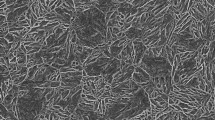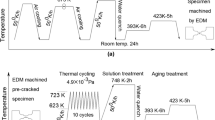Abstract
The hydrogen-related fracture propagation process in martensitic steel was investigated through crystallographic orientation and fracture surface topography analyses. The hydrogen-related fracture surface consisted of three typical surfaces, namely smooth surfaces, surfaces with serrated markings, and surfaces with dimples. Crystallographic orientation analysis suggested that the smooth surface was generated by intergranular fracture at prior austenite grain boundaries, and the surface with serrated markings originated from quasi-cleavage fracture propagated along \(\{011\}\) planes. According to the reconstructed fracture propagation process by fracture surface topography analysis, the intergranular fracture at prior austenite grain boundaries initiated and propagated suddenly at the early stages of fracture. The quasi-cleavage fracture along \(\{011\}\) planes then gradually propagated within the prior austenite grains. At the final stages of fracture, ductile fracture accompanied by dimples occurred around the edge of the specimen. The results clearly indicated that the fracture propagation path changed with the proceeding fracture from the prior austenite grain boundaries to along \(\{011\}\) planes within the prior austenite grains.








Similar content being viewed by others
References
Banerji SK, McMahon CJ Jr, Feng HC (1978) Intergranular fracture in 4340-Type steels: effects of impurities and hydrogen. Metall Mater Trans A 9(2):237–247. doi:10.1007/BF0264670
Cao Y, Nie W, Yu J, Tanaka K (2014) A novel method for failure analysis based on three-dimensional analysis of fracture surfaces. Eng Fail Anal 44:74–84. doi:10.1016/j.engfailanal.2014.04.032
Cao Y, Zhang S, Tanaka K (2013) Calculation method for maximum low-cycle fatigue loads using FRASTA reconstruction data. Int J Fract 182(2):157–166. doi:10.1007/s10704-013-9862-z
Craig B, Krauss G (1980) The structure of tempered martensite and its susceptibility to hydrogen stress cracking. Metall Mater Trans A 11(11):1799–1808. doi:10.1007/BF02655095
Dadfarnia M, Nagao A, Wang S, Martin ML, Somerday BP, Sofronis P (2015) Recent advances on hydrogen embrittlement of structural materials. Int J Fract 196(1–2):223–243. doi:10.1007/s10704-015-0068-4
Geng WT, Freeman AJ, Olson GB, Tateyama Y, Ohno T (2005) Hydrogen-promoted grain boundary embrittlement and vacancy activity in metals: insights from Ab initio total energy calculatons. Mater Trans 46(4):756–760. doi:10.2320/matertrans.46.756
Gludovatz B, Hohenwarter A, Catoor D, Chang EH, George EP, Ritchie RO (2014) A fracture-resistant high-entropy alloy for cryogenic applications. Science 345(6201):1153–1158. doi:10.1126/science.1254581
Kim YH, Kim HJ, Morris JW Jr (1986) The influence of precipitated austenite on hydrogen embrittlement in 5.5Ni steel. Metall Mater Trans 17(7):1157–1164. doi:10.1007/BF02665314
Kim YH, Morris JW Jr (1983) The nature of quasicleavage fracture in tempered 5.5Ni steel after hydrogen charging. Metall Mater Trans A 14(9):1883–1888. doi:10.1007/BF02645559
Kirchheim R, Somerday B, Sofronis P (2015) Chemomechanical effects on the separation of interfaces occurring during fracture with emphasis on the hydrogen-iron and hydrogen-nickel system. Acta Mater 99(11):87–98. doi:10.1016/j.actamat.2015.07.057
Kobayashi T, Shockey DA (1987) A fractographic investigation of thermal embrittlement in cast duplex stainless steel. Metall Mater Trans A 18(11):1941–1949. doi:10.1007/BF02647024
Kobayashi T, Shockey DA (2010) Fracture surface topography analysis (FRASTA)—development, accomplishments, and future applications. Eng Fract Mech 77(12):2370–2384. doi:10.1016/j.engfracmech.2010.05.016
Luppo MI, Ovejero-Garcia J (1991) The influence of microstructure on the trapping and diffusion of hydrogen in a low carbon steel. Corros Sci 32(10):1125–1136. doi:10.1016/0010-938X(91)90097
Lynch SP (1984) A fractographic study on gaseous hydrogen embrittlement and liquid-metal embrittlement in a tempered-martensitic steel. Acta Metall 32(1):79–80. doi:10.1016/0001-6160(84)90204-9
Lynch S (2012) Hydrogen embrittlement phenomena and mechanisms. Corros Rev 30(3–4):105–123. doi:10.1515/corrrev-2012-0502
Martin ML, Fenske JA, Liu GS, Sofronis P, Robertson IM (2011) On the formation and nature of quasi-cleavage fracture surfaces in hydrogen embrittled steels. Acta Mater 59(4):1601–1606. doi:10.1016/j.actamat.2010.11.024
Momotani Y, Shibata A, Terada D, Tsuji N (2015) Hydrogen embrittlement behavior at different strain rates in low-carbon martensitic steel. Mater Today Proc 2S3:S735–S738. doi:10.1016/j.matpr.2015.07.387
Nagao A, Smith SD, Dadfarnia M, Sofronis P, Robertson IM (2012) The role of hydrogen in hydrogen embrittlement fracture of lath martensitic steel. Acta Mater 60(13–14):5182–5189. doi:10.1016/j.actamat.2012.06.040
Robertson IM, Sofronis P, Nagao A, Martin ML, Wang S, Gross DW, Nygren KE (2015) Hydrogen embrittlement understood. Metall Mater Trans B 46(3):1085–1103. doi:10.1007/s11663-015-0325-y
Shibata A, Murata T, Takahashi H, Matsuoka T, Tsuji N (2015) Characterization of hydrogen-related fracture behavior in as-quenched low-carbon martensitic steel and tempered medium-carbon martensitic steel. Metall Mater Trans A 46(12):5685–5696. doi:10.1007/s11661-015-3176-x
Shibata A, Takahashi H, Tsuji N (2012) Microstructural and crystallographic features of hydrogen-related crack propagation in low carbon martensitic steel. ISIJ Int 52(2):208–212. doi:10.2355/isijinternational.52.208
Shiozawa K, Morii Y, Nishino S, Lu L (2006) Subsurface crack initiation and propagation mechanism in high-strength steel in a very high cycle fatigue regime. Int J Fatigue 28(11):1521–1532. doi:10.1016/j.ijfatigue.2005.08.015
Solanki KN, Tschopp MA, Bhatia MA, Rhodes NR (2012) Atomistic investigation of the role of grain boundary structure on hydrogen segregation and embrittlement in \(\upalpha \)-Fe. Metall Mater Trans A 44(3):1365–1375. doi:10.1007/s11661-012-1430-z
Takai K, Seki J, Homma Y (1995) Observation of trapping sites of hydrogen and deuterium in high-strength steels by using secondary ion mass spectrometry. Mater Trans JIM 36(9):1134–1139
Wang M, Akiyama E, Tsuzaki K (2005) Effect of hydrogen and stress concentration on the notch tensile strength of AISI 4135 steel. Mater Sci Eng A 398(1–2):37–46. doi:10.1016/j.msea.2005.03.008
Wang M, Akiyama E, Tsuzaki K (2007) Effect of hydrogen on the fracture behavior of high strength steel during slow strain rate test. Corros Sci 49(11):4081–4097. doi:10.1016/j.corsci.2007.03.038
Wang G, Yan Y, Li J, Huang J, Su Y, Qiao L (2013) Hydrogen embrittlement assessment of ultra-high strength steel 30CrMnSiNi\(_{2}\). Corros Sci 77:273–280. doi:10.1016/j.corsci.2013.08.013
Yamaguchi M, Ebihara K, Itakura M, Kadoyoshi T, Suzudo T, Kaburaki H (2010) First-principles study on the grain boundary embrittlement of metals by solute segregation: Part II. Metal (Fe, Al, Cu)-hydrogen (H) systems. Metall Mater Trans A 42(2):330–339. doi:10.1007/s11661-010-0380-6
Yamaguchi M, Kameda J, Ebihara K, Itakura M, Kaburaki H (2012) Mobile effect of hydrogen on intergranular decohesion of iron: first-principles calculations. Philos Mag 92(11):1349–1368. doi:10.1080/14786435.2011.645077
Acknowledgements
This study was financially supported by a Grant-in-Aid for Scientific Research (B) (No. 15H04158), and the Elements Strategy Initiative for Structural Materials (ESISM), all through the Ministry of Education, Culture, Sports, Science and Technology (MEXT), Japan.
Author information
Authors and Affiliations
Corresponding author
Rights and permissions
About this article
Cite this article
Shibata, A., Matsuoka, T., Ueno, A. et al. Fracture surface topography analysis of the hydrogen-related fracture propagation process in martensitic steel. Int J Fract 205, 73–82 (2017). https://doi.org/10.1007/s10704-017-0182-6
Received:
Accepted:
Published:
Issue Date:
DOI: https://doi.org/10.1007/s10704-017-0182-6




